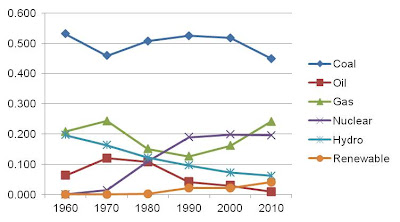For many decades, the U.S. has been slowly decarbonizing the fuel mix it uses to generate power. Here’s a chart I put together that shows the relative shares of coal, oil, natural gas, nuclear, hydropower and non-hydropower renewable sources over 50 years, between 1960 and 2010.

As you can see, coal, oil and hydropower lost market share, while natural gas, nuclear and non-hydropower renewables gained. Overall, the carbon intensity (carbon/BTU of energy) of the U.S. power generation mix dropped by roughly 15 percent from the beginning of the period till the end.
We can also see from the chart that the trends were particularly strong in the first decade of the 21st century, from 2000 to 2010. But what’s happened since then? A second chart shows the same trends from the beginning of 2011 through May, 2012 (the latest available data from the U.S. Energy Information Administration).

Over this short time period, coal continued to lose market share while natural gas and renewable sources other than hydro gained. Because of this substitution, the carbon intensity of the U.S. power generation fuel mix dropped by another 13 percent.
What is likely to happen to this carbon intensity in the future? The Department of Energy has projected the future U.S. power generation fuel mix through 2035 and believes that it is likely to continue towards higher proportions of natural gas and renewable sources and a reduced share of coal. If that happens, U.S. power generation fuel carbon intensity will continue to decline.
Though this declining carbon intensity doesn’t solve the greenhouse gas problem, it helps. And a lot of it is happening because market forces in the U.S. are pushing power generators to make the indicated fuel substitutions. Things aren’t necessarily the same in every country, but in many the same market forces likely will push local power generators to make similar substitutions.

No comments:
Post a Comment